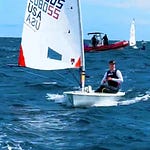I’m grateful that my coach, John Bertand, diligently worked with me to strengthen my high performance mindset and my starting methodology and tactics. "Don't focus on results, focus on the building blocks and learning," he said. My relatively consistent finishes at the 2025 Mid-Winters West regatta in Long Beach, California, were the result of several months of focused practice and coaching, and my willingness to travel to other major regattas before this event, such as Mid-Winters East in St. Petersburg, Florida.
We decided to continue focusing on the ILCA4 over the ILCA6 for my goals, AND on single-handed sailing over the FJ and 420, primarily because:
The 2025 Youth World Championships will be held in Cabrillo Beach, aka “Hurricane Gulch.” I’m competent and confident in my ILCA6 youth-level sailing skills, but as a 16-year-old, I felt this was a better fit (see my next point on why that is).
Ironically, the ILCA (f.k.a. Laser) was designed and initially built in the U.S. The European, Australian, and New Zealand youth programs now dominate the ILCA.
The progression in these regions is to focus heavily on the ILCA4 until about age 17. In Europe, it is common to see a 100- to 150-boat ILCA4 fleet and an additional 150- to 200 boys competing in the ILCA4.
In the U.S., the “4” rig was dismissed as a toy rig, and that “real” competitors need to be in the “6.”
My experience at two World Championships in Portugal and Greece and the 2024 Youth European Championships in Izola, Slovenia, proved this false.
ILCA4 is ideal for developing skills and being in a rig that enables learning and doesn’t cause sailors to be overpowered before they’re physically ready for the 6.
You can’t argue with the results. Australians, Kiwis, and Europeans dominate at many levels in international sailing, while the U.S. struggles to field winning sailors at the highest levels, instead of focusing primarily on youth sailing progressing into 420s and FJs in college sailing. Don’t get me wrong, my sister and dad had a great time sailing in college. But in Europe, for example, college sailing is non-existent.
In the eastern U.S., people are figuring this out now.
So, despite the pull to the 420 for pre-college sailing and the FJ for west coast high school sailing, my coach reminded me that a strong single-handed sailor hones their skills in a physically demanding boat where they are accountable only to themselves. As a result, they can sail anything. This proved to be true when I jumped in a 420 for the Women’s North American Championships and we earned two top-five finishes in a 35-boat fleet with little practice before the event.
My high-performance mindset keeps me focused on weights several mornings per week and pool work for water polo. So far, I have maintained a strong GPA and qualify as a USA Water Polo Academic All-American. This cross-training makes me stronger.
This week, I’m excited to head to New Orleans for the US Sailing women’s clinic.
I’ll share another post soon on my regatta and clinic schedule over the spring and summer.
Thank you for reading my post!
Unequivocally yours,
Paloma








